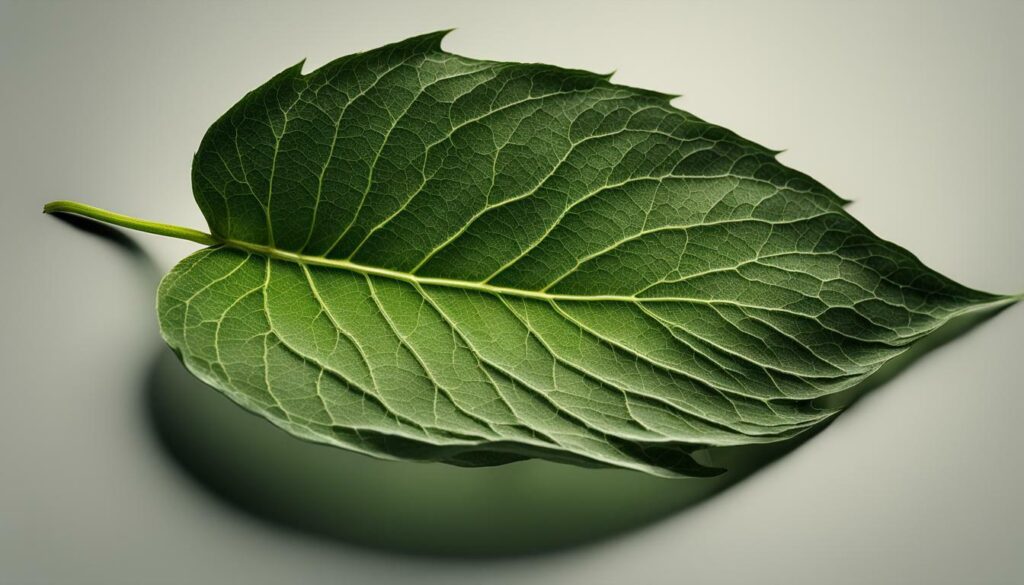Feuille de Tournesol, also known as Helianthus annuus, is a sunflower variety that holds great importance in France due to its impressive beauty and multiple uses. This large annual plant features flowers grouped in magnificent capitules, making it a visually striking ornamental plant. But its appeal goes beyond aesthetics, as its seeds are a valuable source of high-quality edible oil, making it a key player in Europe’s edible oil industry.
One fascinating characteristic of Feuille de Tournesol is its heliotropism. This means that the plant’s stem grows in response to the sunlight, allowing it to effectively capture as much light as possible. It’s a remarkable feature that sets it apart from other plants and contributes to its overall growth and development.
Feuille de Tournesol’s practical uses extend beyond its ornamental and edible qualities. When it comes to watering this sunflower variety, it’s important to use filtered water at room temperature and avoid watering over the foliage. Overwatering can lead to plant diseases, while underwatering can cause the leaves to wilt and turn yellow. Generally, watering once a week is sufficient, but the frequency may vary depending on the soil moisture and weather conditions.
It’s worth noting that the watering needs of Feuille de Tournesol can differ when grown indoors compared to outdoor cultivation. When growing this sunflower variety indoors, watering may need to be more frequent to ensure optimal growth and hydration.
As with any plant, understanding the seasonal watering considerations is crucial. Feuille de Tournesol’s water requirements may vary depending on the different stages of growth and changes in weather conditions. Adjustments in watering practices may be necessary to ensure the plant thrives and stays healthy throughout different seasons.
In conclusion, Feuille de Tournesol is an exceptional sunflower variety that has captured the hearts and attention of many in France. Its beauty, versatility, and historical significance in the country make it a beloved plant that continues to be cherished and utilized for various purposes.
Cultivation of Feuille de Tournesol
Cultivating Feuille de Tournesol is an essential practice in France, as it not only provides high-quality edible oil but also showcases the plant’s fascinating response to sunlight through heliotropism. This variety of sunflower, scientifically known as Helianthus annuus, is a large annual plant with flowers grouped in magnificent capitules. Its seeds are highly sought after for their rich and nutritious oil, making it one of the primary sources of edible oil in Europe.
When it comes to cultivating Feuille de Tournesol, proper attention to watering and soil conditions is crucial. The sunflower’s heliotropism causes its stem to grow in the direction of the sun, allowing it to maximize sunlight exposure throughout the day. This unique characteristic plays a significant role in the plant’s growth and overall health.
To ensure optimal growth and oil production, it is recommended to water Feuille de Tournesol with filtered water at room temperature. Watering over the foliage should be avoided to minimize the risk of plant diseases. Overwatering can have detrimental effects, leading to root rot and other issues. Conversely, underwatering can result in wilting and yellowing of the leaves.
| Watering Frequency | Soil Moisture and Weather Conditions |
|---|---|
| Generally, once a week is sufficient for watering Feuille de Tournesol. | The watering frequency may vary depending on the moisture in the soil and weather conditions. |
As the plant goes through different growth stages and seasons change, adjustments in watering practices may be necessary. During periods of active growth, such as flowering and seed development, Feuille de Tournesol may require more frequent watering to support its physiological needs.
When growing Feuille de Tournesol indoors, it is important to note that watering may need to be more frequent than when grown outdoors. The indoor environment often has lower humidity levels, which can lead to faster moisture loss in the soil.

- Cultivating Feuille de Tournesol is an essential practice in France, primarily for its high-quality edible oil and the plant’s fascinating heliotropism response to sunlight.
- Proper watering techniques, such as using filtered water at room temperature and avoiding overwatering or underwatering, are crucial for the plant’s health and overall growth.
- The watering frequency depends on factors such as soil moisture, weather conditions, growth stage, and indoor or outdoor cultivation.
With its versatility as a source of edible oil and its captivating ornamental appeal, Feuille de Tournesol continues to be a cherished plant in France, embodying the beauty and significance of sunflowers.
| Key Cultivation Points | Key Considerations |
|---|---|
| Use filtered water at room temperature | Proper watering techniques are crucial for plant health |
| Avoid overwatering and underwatering | Adjust watering frequency based on growth stage and seasonal changes |
| Heliotropism response to sunlight is a unique characteristic | Indoor cultivation may require more frequent watering |
Ornamental Uses of Feuille de Tournesol
In addition to its practical uses, Feuille de Tournesol is widely treasured for its ornamental appeal, with its stunning capitules adding a touch of beauty to gardens and landscapes. These large, vibrant flowers, ranging in colors from deep yellows to fiery oranges, create a striking visual display that is sure to captivate any passerby.
Feuille de Tournesol’s ornamental value lies not only in its vibrant colors but also in the unique structure of its capitules. Composed of hundreds of tiny individual flowers, the large, round capitules form an eye-catching focal point in any garden. They make excellent cut flowers, bringing a burst of sunshine indoors and brightening up any floral arrangement.
Whether planted in borders, grouped together in flower beds, or used as a backdrop in a landscape, Feuille de Tournesol adds a touch of elegance and charm to any outdoor space. Its tall, sturdy stems provide an impressive vertical element and make it an ideal choice for creating height and visual interest in garden designs.

Table: Recommended Varieties of Feuille de Tournesol for Ornamental Purposes
| Variety | Flower Color | Height |
|---|---|---|
| Sol Invictus | Yellow | 5-6 feet |
| Autumn Beauty | Mixed Colors | 4-5 feet |
| Italian White | White | 4-6 feet |
| Red Sun | Red | 5-7 feet |
These recommended varieties of Feuille de Tournesol are known for their exceptional ornamental qualities and are highly sought after by garden enthusiasts. Planting a combination of these varieties will create a visually stunning display of colors and heights, adding drama and charm to your outdoor space.
Watering Feuille de Tournesol
Proper watering is crucial for the health and growth of Feuille de Tournesol, requiring filtered water at room temperature and adherence to the right watering frequency. When it comes to watering this sunflower variety, it is important to consider certain factors to ensure optimal conditions for its cultivation.
Firstly, using filtered water is recommended to avoid potential contaminants that may hinder the plant’s growth. Tap water may contain chemicals or minerals that can be harmful to Feuille de Tournesol, so opting for filtered water is a safer choice.
Additionally, it is best to water the plants with room temperature water. Extreme temperatures, either too hot or too cold, can shock the plant and affect its overall health. By using water at room temperature, you provide a gentle and consistent environment for Feuille de Tournesol to thrive.
Watering Frequency
The watering frequency for Feuille de Tournesol will depend on various factors including the moisture level of the soil and the prevailing weather conditions. As a general guideline, watering once a week is typically sufficient. However, it is essential to monitor the soil moisture regularly to ensure that it does not become excessively dry or waterlogged.
During the plant’s early growth stage, it is crucial to keep the soil consistently moist but not overly saturated. As the plant matures and establishes a stronger root system, you can gradually reduce the watering frequency, allowing the soil to dry slightly between waterings. This helps promote healthy root development and prevents the risk of fungal diseases caused by overwatering.
It is important to note that watering requirements may change depending on the specific weather conditions, especially during hot and dry periods. In such cases, you may need to increase the frequency of watering to ensure that the plant receives adequate moisture.

| Watering Tips for Feuille de Tournesol |
|---|
| Use filtered water at room temperature. |
| Monitor soil moisture regularly to avoid overwatering or underwatering. |
| Water once a week, adjusting for weather conditions. |
| Avoid watering over the foliage to prevent the risk of fungal diseases. |
In conclusion, proper watering is essential for the successful cultivation of Feuille de Tournesol. By using filtered water at room temperature and following the appropriate watering frequency, you can provide the optimal conditions for the plant’s growth. Remember to monitor soil moisture regularly and adjust watering practices based on weather conditions to ensure the health and vitality of this beautiful sunflower variety.
Watering Feuille de Tournesol Indoors
When cultivating Feuille de Tournesol indoors, the watering frequency may differ from outdoor cultivation due to variations in environmental conditions. The limited access to natural rainfall and direct sunlight indoors can affect the moisture levels of the soil and the overall water requirements of the plant. Therefore, it is essential to closely monitor the watering needs of your indoor sunflowers to ensure their health and vitality.
Indoor sunflower cultivation typically necessitates more frequent watering compared to outdoor growth. The controlled environment indoors can result in faster evaporation and drying of the soil, calling for regular hydration of the plants. To determine the optimal watering frequency, it is crucial to assess the moisture levels of the soil.
Watering Frequency Guidelines for Indoor Sunflowers:
- Check the moisture levels of the soil by inserting your finger about an inch deep into the soil. If it feels dry, it’s time to water the plant. If it feels moist, it is best to wait a day or two before watering.
- Use filtered water at room temperature to avoid shocking the plant’s root system. Avoid using cold water straight from the tap, as it can hinder the plant’s growth and development.
- Water the plant thoroughly, ensuring the entire root ball is sufficiently hydrated. Avoid overwatering, as it can lead to waterlogged soil and root rot.
- Monitor the plant for any signs of underwatering or overwatering, such as wilting or yellowing leaves. Adjust the watering frequency accordingly.
By following these guidelines, you can ensure that your indoor Feuille de Tournesol thrives in its controlled environment. Remember to regularly assess the moisture levels of the soil, provide filtered room temperature water, and pay attention to the plant’s response to ensure optimal growth and health.

| Watering Frequency | Indoor Cultivation | Outdoor Cultivation |
|---|---|---|
| Spring | Every 4-5 days | Every 7-10 days |
| Summer | Every 2-3 days | Every 4-5 days |
| Fall | Every 4-5 days | Every 7-10 days |
| Winter | Every 7-10 days | Every 10-14 days |
Effects of Overwatering and Underwatering
Understanding the effects of overwatering and underwatering is crucial for maintaining the health and vitality of Feuille de Tournesol, as both can negatively impact its growth and appearance.  Overwatering, which refers to providing excessive amounts of water to the plant, can lead to various issues. One of the most common consequences of overwatering is the development of plant diseases. When the soil is constantly saturated, it creates a favorable environment for fungal growth and root rot. These conditions can cause the plant’s roots to become weak and susceptible to infection, resulting in wilting, yellowing leaves, and stunted growth.
Overwatering, which refers to providing excessive amounts of water to the plant, can lead to various issues. One of the most common consequences of overwatering is the development of plant diseases. When the soil is constantly saturated, it creates a favorable environment for fungal growth and root rot. These conditions can cause the plant’s roots to become weak and susceptible to infection, resulting in wilting, yellowing leaves, and stunted growth.
On the other hand, underwatering, which occurs when the plant does not receive enough water, can also have detrimental effects. When Feuille de Tournesol is underwatered, it struggles to absorb the necessary nutrients from the soil, leading to inadequate growth and weakened vitality. The leaves may appear wilted, dry, and discolored, and the plant may become more susceptible to pests and diseases. Underwatering can also cause the plant to produce fewer flowers, impacting its ornamental beauty.
To avoid the negative effects of overwatering and underwatering, it is important to find the right balance in watering Feuille de Tournesol. This can be achieved by using filtered water at room temperature and avoiding watering over the foliage. Instead, focus on providing water directly to the base of the plant. The ideal watering frequency will depend on the moisture level of the soil and the weather conditions. As a general guideline, watering once a week is often sufficient, but it is crucial to monitor the plant’s needs and adjust accordingly.
Seasonal Watering Considerations
Adjusting the watering practices of Feuille de Tournesol based on seasonal variations and its growth stages is essential to ensure optimal growth and health. Sunflowers have different water requirements at various stages of their life cycle and respond to changes in weather conditions. By understanding these seasonal considerations, you can provide the right amount of water to support the sunflower’s development.
During the spring and early summer, when Feuille de Tournesol is in its vegetative stage, it requires consistent moisture to support vigorous growth. Regular watering is necessary to maintain soil moisture levels, especially during dry spells. Adequate water supply will facilitate the sunflower’s ability to develop strong stems and a robust root system.
As the sunflower transitions into its flowering stage during mid to late summer, it is crucial to monitor the water requirements closely. While sunflowers are resilient plants, excessive heat and prolonged dry periods can impact their ability to produce vibrant flowers. Increase the watering frequency and ensure the soil remains consistently moist, but avoid overwatering, as it can lead to root rot and other issues.
During the autumn months, Feuille de Tournesol begins to prepare for dormancy. Reduce the frequency of watering as the plant transitions into its seed maturation phase. However, ensure the soil does not completely dry out, as adequate moisture is still necessary to support the development of healthy seeds. Monitoring the soil moisture content and adjusting watering accordingly will help prevent under or overwatering and promote successful seed formation.
Table: Seasonal Watering Guidelines
| Season | Watering Recommendations |
|---|---|
| Spring and Early Summer (Vegetative Stage) | Consistent watering to maintain soil moisture levels |
| Mid to Late Summer (Flowering Stage) | Increase watering frequency to support flower development |
| Autumn (Seed Maturation Phase) | Gradually reduce watering while ensuring adequate moisture for seed formation |
By following these seasonal watering guidelines, you can help your Feuille de Tournesol thrive throughout its growth cycle. Remember to observe the plant closely and adjust watering practices based on its specific needs and environmental conditions. With proper care, you can enjoy the beauty and benefits of this remarkable sunflower variety.

In conclusion, Feuille de Tournesol is not only a remarkable sunflower variety but also holds great significance in France, both in terms of its cultivation and ornamental appeal. As a variety of Helianthus annuus, this large annual plant with its beautiful flowers grouped in large capitules is cultivated for its high-quality edible oil. It is a major source of this oil in Europe, contributing to the culinary traditions and economy of the country.
Feuille de Tournesol is also known for its unique characteristic of heliotropism, wherein the stem grows in response to sunlight. This adaptation allows it to maximize exposure to the sun, ensuring proper growth and development. Moreover, its striking capitules make it a popular choice for ornamental purposes, adding beauty to gardens and landscapes across France.
When it comes to watering Feuille de Tournesol, it is important to use filtered water at room temperature to prevent any damage to the plant. Avoiding watering over the foliage is also crucial, as it can lead to the development of plant diseases. Overwatering should be avoided, as it can have detrimental effects on the plant’s health, while underwatering may result in wilting and yellowing of the leaves.
The ideal watering frequency for Feuille de Tournesol depends on the moisture level of the soil and the prevailing weather conditions. Generally, watering once a week is sufficient, but it is important to assess the specific needs of the plant. Additionally, different stages of growth and varying seasons may require adjustments in watering practices to ensure the optimal health and vitality of the sunflower.
FAQ
How can I water Feuille de Tournesol?
It is best to water Feuille de Tournesol with filtered water at room temperature. Avoid watering over the foliage to prevent plant diseases.
What are the consequences of overwatering and underwatering Feuille de Tournesol?
Overwatering can lead to plant diseases, while underwatering can cause wilting and yellowing of the leaves.
How often should I water Feuille de Tournesol?
The watering frequency depends on soil moisture and weather conditions. Generally, once a week is sufficient, but different growth stages and seasons may require varying amounts. Adjust accordingly.
Is the watering frequency different for indoor cultivation of Feuille de Tournesol?
Yes, when growing Feuille de Tournesol indoors, watering may be more frequent than when growing outdoors. Monitor the moisture levels and adjust as needed.
What are the ornamental uses of Feuille de Tournesol?
Feuille de Tournesol is often used for decorative purposes due to its spectacular capitules. It adds beauty to gardens and landscapes.
- Comment s’occuper de tulipe? - October 22, 2023
- Tulipe qui se ferme la nuit? - October 22, 2023
- Ou acheter tulipe? - October 22, 2023







